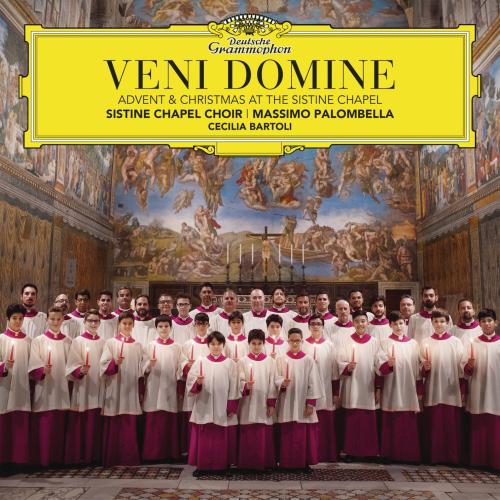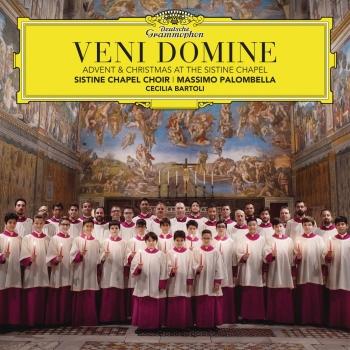
Veni Domine: Advent & Christmas At The Sistine Chapel Sistine Chapel Choir, Massimo Palombella & Cecilia Bartoli
Album Info
Album Veröffentlichung:
2017
HRA-Veröffentlichung:
27.10.2017
Label: Deutsche Grammophon (DG)
Genre: Classical
Subgenre: Choral
Interpret: Sistine Chapel Choir, Massimo Palombella & Cecilia Bartoli
Komponist: Josquin Desprez (1440-1521), Pérotin, Giovanni Pierluigi da Palestrina (1525-1594), Giovanni Maria Nanino (1544–1607), Jean Mouton (1459-1522), Tomas Luis de Victoria, Gregorio Allegri (1582-1652), Jacobus Clemens non Papa
Das Album enthält Albumcover Booklet (PDF)
Entschuldigen Sie bitte!
Sehr geehrter HIGHRESAUDIO Besucher,
leider kann das Album zurzeit aufgrund von Länder- und Lizenzbeschränkungen nicht gekauft werden oder uns liegt der offizielle Veröffentlichungstermin für Ihr Land noch nicht vor. Wir aktualisieren unsere Veröffentlichungstermine ein- bis zweimal die Woche. Bitte schauen Sie ab und zu mal wieder rein.
Wir empfehlen Ihnen das Album auf Ihre Merkliste zu setzen.
Wir bedanken uns für Ihr Verständnis und Ihre Geduld.
Ihr, HIGHRESAUDIO
- Traditional:
- 1 Introit "Gaudete in Domino semper" 04:26
- Pérotin (fl. ca. 1200):
- 2 "Beata viscera Mariae Virginis" 03:48
- Traditional:
- 3 Hymn "Conditor alme siderum" 03:36
- Josquin Desprez (ca. 1455-1521):
- 4 Motet "Missus est Gabriel" 03:21
- Giovanni Pierluigi da Palestrinaca (ca. 1525-1594):
- 5 Motet "Canite tuba in Sion - Rorate, caeli, desuper" 06:06
- Giovanni Maria Nanino (ca. 1543-1607):
- 6 Motet "Hodie nobis caelorum Rex - Gloria in excelsis Deo" 05:18
- Giovanni Pierluigi da Palestrina:
- 7 Motet "Hodie Christus natus est" 03:23
- Jean Mouton (ca. 1459-1522):
- 8 Motet "Queramus cum pastoribus" 04:32
- Tomas Luis de Victoria (1548-1611):
- 9 Motet "Quem vidistis, pastores - Dicite, quidnam vidistis" 05:03
- Giovanni Pierluigi da Palestrina:
- 10 Motet "Dies sanctificatus illuxit nobis" 02:36
- Gregorio Allegri (1582-1652):
- 11 "Nasceris, alme puer" 04:22
- Traditional:
- 12 "Christe, Redemptor omnium" 04:49
- Tomas Luis de Victoria:
- 13 "O magnum mysterium" 02:46
- Jacobus Clemens non Papa (ca. 1510- ca. 1556):
- 14 Motet "Magi veniunt ab oriente - Magi, videntes stellam" 05:18
- Giovanni Pierluigi da Palestrina:
- 15 Offertory "Reges Tharsis et insulae" 02:21
- 16 Offertory "Diffusa est gratia" 02:51
Info zu Veni Domine: Advent & Christmas At The Sistine Chapel
Alte Musik in seiner besinnlichsten und meditativsten Form: Der Päpstliche Chor der Sixtinischen Kapelle widmet sich auf seinem neuen Album bei Deutsche Grammophon gregorianischen Chorälen und polyphonen Kompositionen zur Advents- und Weihnachtszeit. Getragen von der außerordentlichen Akustik der Sixtinischen Kapelle, präsentiert der älteste Chor der Welt einige Erstaufnahmen von Werken großer Komponisten wie Palestrina, Nanino und Allegri. Das Ergebnis ist eine tiefe musikalische Kontemplation über die Geburt Christi. Erstmals in der Geschichte, lädt der Chor eine Frau als Gast zu einer gemeinsamen Aufnahme ein: Niemand geringeres als die große Mezzosopranistin Cecilia Bartoli. In dem mittelalterlichen Stück "Beata viscera" von Perotin gibt Cecilia Bartoli im innigen musikalischen Dialog mit den Männer- und Kinderstimmen ein berührendes Zeugnis ihrer intensiven Ausdruckskraft. Das Album bietet einen außergewöhnlichen musikalischen Zugang zur Weihnachtszeit, der fern romantisierender Klänge den Hörer mit kontemplativer Dichte, Ausdruckskraft und tiefer Religiosität in den Bann zieht. Filigran und komplex, wendig und transparent entfaltet sich das feine Geflecht der Stimmen und mündet in einem weichen Gesamtklang von vollendeter Ausgewogenheit.
Chor der Sixtinischen Kapelle
Cecilia Bartoli, Mezzosopran
Massimo Palombella, Leitung
Sistine Chapel Choir
The Pontifical Musical Chapel “Sistina”, commonly known as the Choir of the “Sistine Chapel” is the chorus of the liturgical celebrations of the Supreme Pontiff. Present since the first centuries of the Church, it was reorganized in the sixth century by Pope St.Gregory the Great, underwent major changes under Boniface VIII, and it was reorganized by Sixtus IV in 1471; since then, the Pontifical Musical Chapel became the Pope’s personal choir and was renamed “Sistina choir” as a tribute to the man who revived it, and because usually the choir sang in this chapel. During the Renaissance, Singers Chapel “Sistine”, among others, were Giovanni Pierluigi da Palestrina, Luca Marenzio, Cristobal Morales, Costanzo Festa, Joaquin de Prés and Jacob Arkadeh. In the nineteenth century the Chapel had as its illustrious directors composers such as Giuseppe Baini and Domenico Mustafa. In 1898, Maestro Lorenzo Perosi became the director and, in 1956, Domenico Bartolucci. From 1997 to 2010 it was directed by Msgr. Giuseppe Liberto. On October 16th, 2010 His Holiness Benedict XVI appointed Msgr. Massimo Palombella Master Director of the Sistine Chapel Choir. In addition to its main commitment under the Papal Liturgy, the Choir of the Sistine Chapel in its totality as well as with only the White Voices section, performs in concerts around the world where, through the historical heritage of music for Liturgy, it carries out, according to its mandate, a work of Evangelization.
Booklet für Veni Domine: Advent & Christmas At The Sistine Chapel









